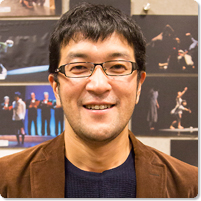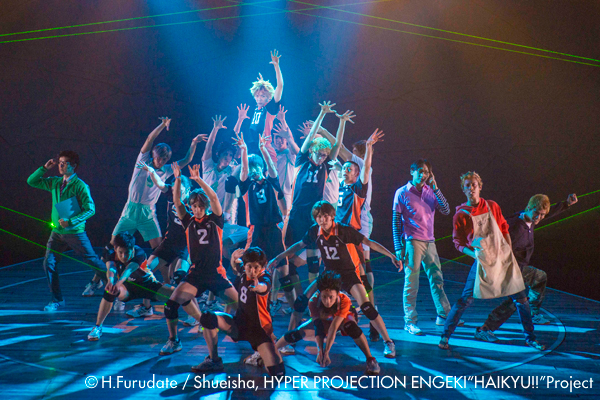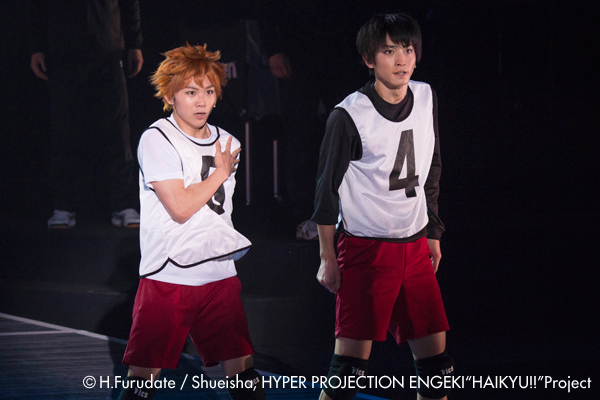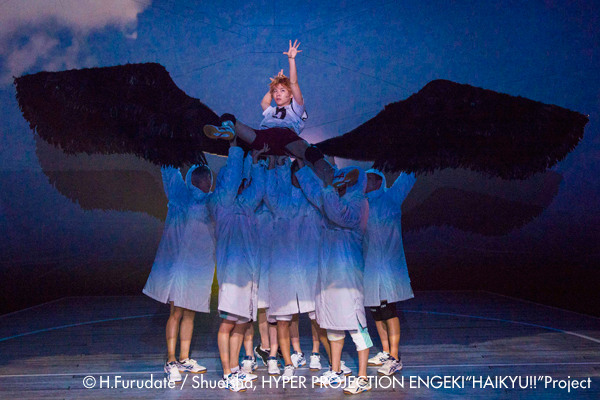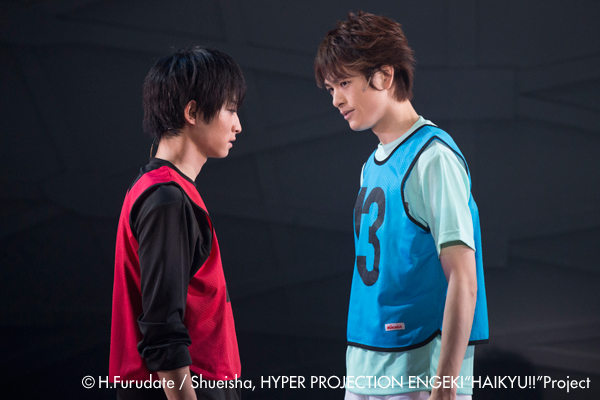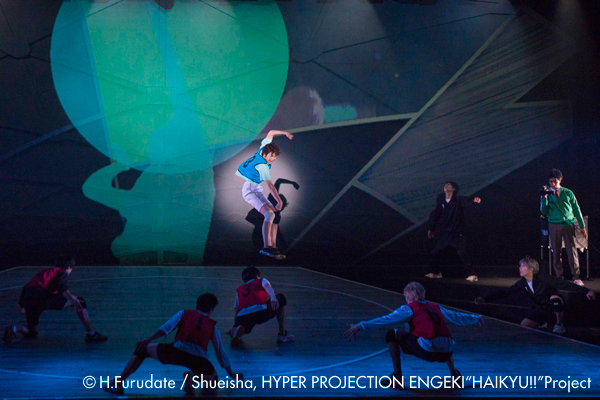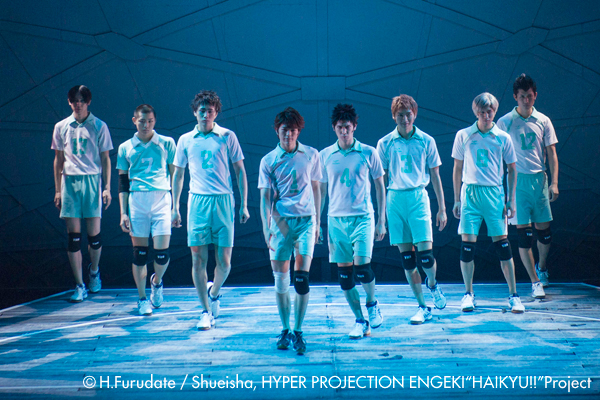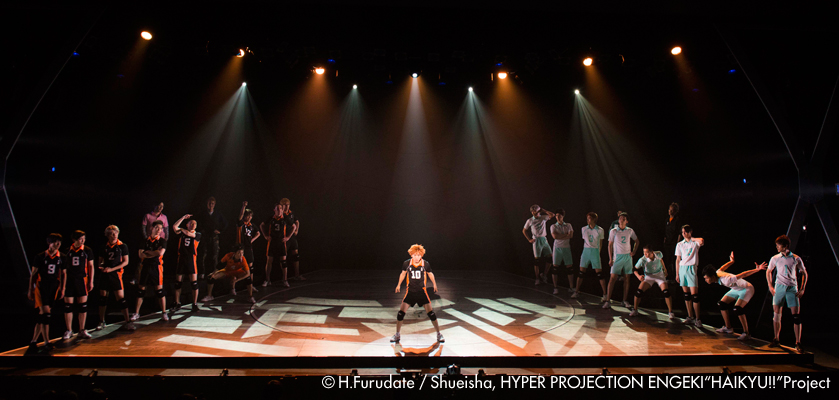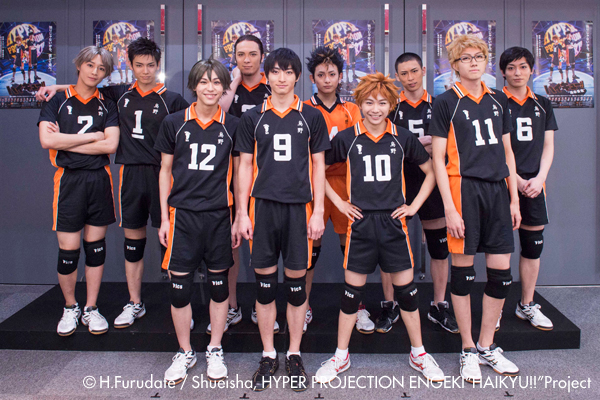From small theater to non-verbal performance
- In college you started a theater group, but would you begin by telling us what you first encounter with theater was?
- In middle school and high school I did sports, so in college I thought that I would like to join some kind of culture-related circle. I was looking at the various circles and wondering if I should try doing music or making movies, and that was when I found a girl handing out leaflets for the theater group Jiyu Gekijo and it had Shoji Koukami’s name on it, so I was interested to go see the performance. At the time, I wasn’t really aware of Koukami-san as a theater-maker, only as a personality appearing on the radio program “All Night Nippon” that I liked. That was the first real theater performance that I saw, and even the moment when the music reached a climax after all the audience was in and seated and the lights suddenly went out thrilled me (laughs). At the next moment, the lights came on and the actors were lined up on the stage and began reciting in chorus.
- It was a student theater group’s performance of Koukami-san’s Asahi no Yo na Yuhi wo Tsurete , wasn’t it?
- Yes. That performance immediately got me fascinated with theater. But, it wasn’t that it made me want to become an actor. I wanted to become a member of the stage crew, and for two years after that I worked doing stage art and lighting and became involved in the production work. After that, I decided I wanted to write plays, so in 1993 I started the unit Gekidan Sekaiichi-dan with members of Jiyu Gekijo. At the time, the theater circles from Osaka University and Osaka Institute of Technology were pursuing activities in tent-style theater performances very seriously and I was able to borrow a tent and set it up in Portopia Land for our inaugural performance. I happened to be just at Christmas time [an important dating time for couples in Japan] and (perhaps due to my own misguided sense) I felt that we, doing theater in our shoddy stage clothes were cooler than the couples going into the hotel right in front of our tent. That got me even more hooked on theater-making (laughs).
- Did you feel rewarding results from those early efforts as a scriptwriter and director?
-
At first, I had a strong desire to become a writer, and I was only doing the directing because there was no one else to do it for us. A turning point came in 2001. That was when the Kobe Arts Village Center (KAVC) that had provided me with opportunities like serving as the venue for my company’s performances there, asked me if I wanted to do a production for performance with their sponsorship as part of the local recovery program for the fifth year after the Great Hanshin Awaji Earthquake. KAVC is a comprehensive arts and culture complex that was established in 1995, the year of the Great Hanshin Awaji Earthquake. In light of the significance of the disaster, I thought it would be best to plan something with wider appeal that could attract a larger viewing audience, so I proposed a festival.
Rather than presenting solely theater, I wanted to include dance and manzai comedy, music and numerous artists from other types of performance, so that people could come and enjoy a number of different short performances in the same day, like a rock festival. This became the “KOBE Short Play Festival.” For it, I wouldn’t present any works of my own but rather focus entirely on the role of festival director. This got me involved with many works by artists from different performance genres and made me realize that, even though the points of departure and ways of climbing were different for each, they were all striving to climb the same mountain. It also happened to be at a point where I had come to feel the limitations of what I could do with my company and I was thinking that I wanted to explore new and different ways of climbing that mountain, so I decided in 2002 to form a new group named THE ORIGINAL TEMPO with creators in other genres including music, art, design and film/video. - The catch phrase of THE ORIGINAL TEMPO is “a performance group made up of sound, light and everyday commodities.” The group’s unique form of playful non-verbal performance using music (rhythm), prop and light called “Shut up, Play!!” (premiere performance: 2007) has been highly acclaimed, winning five stars in the Fringe program of the Edinburgh International Festivals of 2008 and 2009 and being invited to the 2013 Sibiu International Theater Festival.
-
When we first started the unit, the performances included conventional spoken parts from scripts. In between the main performances we did short improvisational plays much like comedy skits, but in the process of doing some skits where the main character didn’t speak a single word, we began to realize the potential of “non-verbal performance.” Instead of using words, we would do things like tossing a cup from a table back and forth between each other. This in turn gave birth to new rhythms or tempos that would give it definition as a scene. Since some of the participants in these performances were originally musicians, if we had them play their instruments in time with the movement, I felt that it made the scenes viable as performance. That was the discovery that led to the birth of our “Shut up, Play!!” performances.
Although I started theater with the desire to become a playwright, I have reached a point where I realized that I had no difficult childhood or family crisis or trauma in my past that I felt I simply had to write about, and I had lost my vision of what I should write. Doing stages with THE ORIGINAL TEMPO gave me a chance to re-evaluate the possibilities of the job of directing, and feeling that I had nothing in me that I needed to write about, I came to realized that I was better suited to directing as a job that allowed me to look at the present before my eyes, change my viewpoint and use directing to create new worlds.
In 2007, I also participated in an event called “Terayama Haku (exhibition) – Engeki-hen” organized by the Osaka small theater IST Zerobankan. The theme was to re-construct [three] Shuji Terayama plays in one hour, and what I did was to create a collage of words from [Terayama’s] essays, poems and famous quotes under the title “Throw out the books, get out on the streets, etc.” In the research I did for that I did for that project, I became fascinated with the activities of Terayama san’s Theater Laboratory – Tenjo Sajiki. The attitude he showed toward street theater, the aspirations regarding overseas theater and the like have had a major influence on my activities since then. - By the way, are there any theater-makers of your own generation that have influenced you?
- In Osaka, I was in an environment where I could see that works of companies of my generation and slightly older companies from around the Kansai region at venues like the Ogimachi Museum Square, and at the Kintetsu Theater I could see at the same time the “Daisan Butai” (Third theater) and Yume no Yuminsha and other companies that came from Tokyo to perform there. Foremost among the things I remember from that period was the play Mohaya Koromade (script and direction by Koki Mitani) that I saw in my college years in a performance by Tokyo Sunshine Boys. It was one of the quieter of the plays performed by the Sunshine Boys, but unlike other more conceptual plays, it was a situation comedy that showed Mitani’s commitment to easy-flowing conversational style, and I feel that it reawakened me to another interesting side of theater.
- An important aspect of your stages is the way you use music and visual elements like video. What is the source of these elements in your style?
-
Actually, music is one of the things I am weakest in. In my [student] days I listen to a lot of different music, but I didn’t find anything that I could really get into; to the degree that it became a sort of complex within me. But, when I was in Jiyu Gekijo, one of my seniors lent me about 100 CDs and told me that I should at least get familiar with these types of music and musicians. So, I was more or less coerced in that way into getting an intensive course in music. With regard to Western music, it was a rather systematic introduction where I was told things like, “If you are going to listen to the Beatles, you also have to listen to the black music that they drew on. I am still indebted today to the knowledge that I acquired at that time.
As for video and visual art, I owe a lot to the experimental things I was allowed to do in our productions at KAVC in the early years of my theater career. At the time, there were producers like Akiko Okano and Fumiko Fukushima at KAVC, and they enabled me to do productions at a pace of about once a year. At KAVC there is a theater halls as well as a movie theater and gallery spaces, so I was able to create productions that used the hall and the movie theater at the same time, and I was also able to take on the challenge of working in collaboration with artists from other genres.
Normally, a theater company has its creators in the actors, playwrights and directors and then the technical planners that outsource other work as necessary to put a production together. But, I have come to feel that the opposite direction of work flow is better, and at first, after starting The Original Tempo, I had a team that consisted only the [production: staff. I have heard that for his productions, Philippe Decouflé spends the winters in the studio with his staff creating the things like puppets and stage art that he uses in his works, and I too prefer to place weight on the time spent creating things with the planners rather than time in the studio working with the actors. - And does that time include working on the play (script) itself?
-
Of course a script (text) and words are essential parts of a work, but it can also be said, conversely, that words are only one part, just like music, lighting and the other parts are. Just like the choice of saying, “This time we will do a work or scene without music,” I believe it is fine to have the choice of saying, “This time we will not use words,” and that is the stance I rake with our work in THE ORIGINAL TEMPO.
The general rule in theater is that the actor reads the play and memorizes his or her part before coming to rehearsals, and although it may sound a bit exaggerated to say so, I feel that this definition of theater is one that can limit the number of people who would otherwise be capable of performing on stage. Even if you can’t memorize long lines, you may be a person who could perform on the stage as a dancer for example. So, I wanted to open the door to the stage to a wider range of performers and people capable of artistic expression in my productions; I wanted to engage in creation that didn’t rely solely on words. By the way, as a form of training for our actors, we have rehearsals where we take a play, or a work with a script and say, “Now let’s act out the whole thing without speaking a word.” - How do you go about creating a stage work without using a script?
- The origin of the idea may be a single painting or photograph, or as I mentioned earlier, it may originate from just a cup on a table. While looking at the painting, you may begin to spin a tale of words, or you may begin to add music to the movement of the cup, and there are cases where the cup may take on the role of the main character in some existing story. As a form of group creation, we all work together to create the work. In part, this may connect to the feeling I talked about earlier of my lack of a core as a writer. It is through communication with others that ideas for creation are born. I believe that is the kind of director I am.
- Is it the fact that in the early stage of your career you were involved in directing a festival that led to this kind of creative method?
-
That’s part of it, but it is also due to the fact that in my work with my own theater company I experienced again and again that, rather than having the actor do what I wanted to do, we clearly got better results when I had the actors do things they wanted to try, things they said they wanted to do. It was a company where not all were accomplished actors to begin with, it was better for the work and for them if we proceeded by having them try forms of expression that they had discovered of their own initiative and wanted to try. It was those experiences that led to the type of working method I have today.
Directing an “idol group” leads to the world of 2.5-D musicals
- In recent years, you have also been active as a director for a number of productions such as the “Hyper-projection theater” production Haikyu!! based on the popular manga of the same name. What was it that got you into this type of production?
- When a public comeback was planned for the “idol” group “Tokyo Performance Dolls” (TPD), a project was launched to stage a one-year long run of performances at the former movie theater CBGK Shibugeki!!. The producer of the project had seen my non-verbal performance and productions using projection mapping and he appointed me director based on them. For the project, I then created a fusion of live performance and theater titled PLAY×LIVE “1×0” in 2013.
- That long-run production you created for the idol group was surely very different from the small-theater works you had created in the past. Did it bring any new discoveries or changes in your creative method?
-
Before I did “1×0,” I had the opportunity to do international collaborations in South Korea and Slovakia thanks to the overseas performances we had done as THE ORIGINAL TEMPO. In Slovakia, the working method had been that I created a work based on thorough interviews and research with the people there. That was the first time that I had worked in collaboration with people from completely different contexts, cultural backgrounds and common artistic backgrounds, and it naturally resulted in some problems, but I soon realized that, as with any work, we should approach it with a flat and clear mindset like you would need when seeing something for the first time. That has become the same approach I continue to use today when directing a new production.
So, in the case of TPD, where the group is all girls in their teens, it was the same approach as when I worked with foreigners (laughs). It began from a state where the language we spoke was considerably different and communication difficult, and from there I focused on getting to understand each other little by little and expanding the number of shared concepts we could work with in the joint creative process. Since the mission was to bring all of their appeal as “idols” to the front in the performances, I worked using the image of the [all-female] Takarazuka Review performances. The first half of the work was composed like a regular theatrical drama, and then I staged the second half as an idol stage show, with all of the girls playing themselves as members of the idol group, so that there would be a cohesive unity between the worlds of the first and second halves and the audience would get a feeling of affinity with them and experience the emotions of working together for the success of the idol show that would play out in the second half. In the staging we used projection mapping and “smart glasses” for reading the projected profiles and information about the individual idols of the group that the fans followed.
Unlike with regular theater plays, the audience would be coming to the performances with the desire to link their own lives to those of the idols and the roles they performed on stage. The experience I got from thinking about what to communicate through such a work to that kind of audience and how to fulfill the audiences expectations was one that I would learn a lot from that I could later apply in creating the subsequent stages of 2.5-D musicals that I have directed since then. With 2.5-D musicals (productions that bring the 2-dimensional (2-D) worlds of manga or anime into the 3-dimensional (3-D) world of stage productions using live actors, thus dubbed 2.5-D), the question of how and what you communicate with the audience is very important. - After that, the next project you undertook was bringing the [manga] Haikyu!! , a story about players on high school volleyball teams, to the stage. Such works that bring manga, anime and video game stories to the stage with live actors are generally called 2.5-D musicals, and today they have become a genre that is attracting a lot of attention. Haikyu!! has become one of the big hits of this new genre.
-
To tell the truth, I had never seen any of the existing 2.5-D musicals before I worked on
Haikyu!!
. What’s more, I had never read any of the manga they are based on (laughs). When I was a student, I had read some of the popular weekly manga magazines, but after that I had only read a few books of works by a select number of manga authors. When I was invited to direct [
Haikyu!!
], I told the producer
Makoto Matsuda
that, he told me not to worry, since he had chosen me because he wanted to use the original contents in order to make a new kind of theater for the stage. Thanks to those words, I was able to approach the job without any unnecessary worries in that aspect.
When I read the original manga Haikyu!! , found that it was different from other Japanese sports manga in that it wasn’t full of things like the “killer moves” or magical pitches or kicks that the star players had mastered. At the risk of being misunderstood, I would say that Haikyu!! is a story about players in one of the sports Japanese high schoolers play that is less glamorous than other sports such as baseball or soccer. As I read the original over several times, I began to get the feeling that it was a story that would be more interesting staged as a human drama [rather than a sports drama]. And that is what I said when I met to discuss things with the scriptwriter for the production, Norihito Nakayashiki (playwright and director for the theater company Kaki-kuu-kyaku). - What kind of discussion went on between the two of you in those meetings?
-
Nakayashiki was a big fan of the original
Haikyu!!
manga. When I told him that I wanted to stage it as work with strong performance elements, he said that he would prepare a script composed purely of selected dialogues [lines] from the original with no stage directions whatsoever. So, our roles in creating the final stage script were clearly divided. Nakayashiki would create the flow of dialogue between the characters and I would be in charge of staging the scenes of the volleyball action.
During the creative process, we had discussions with the editor in charge of the original manga and he told me, “ Haikyu!! is an outstanding work and it is complete as it is in manga form, but since it is impossible to duplicate that excellence as it is in a stage production, so I hope you will create a work that is equally outstanding and convincing [for the fans] as a stage production. And I trust you [Worry Kinoshita] to make the changes and creative work to achieve that.” To this day I am extremely grateful for those words of trust. At the same time, I must say that because of his respect for the original manga, Nakayashiki didn’t make any irresponsible changes in the original. - When looked at as performance in terms of the directions in the stage script, for example in the volleyball match scenes, they are composed of a variety of elements, including such things as the projection mapping and dance, live (real-time) video images, etc. How did you bring all these elements together to compose the scenes?
-
The stage script took the form of a storyboard with stage directions right down to the standing positions of the actors.
In the creative process for the action scenes, we didn’t bring the actors in at first, I was just me and the choreographer and the dancers working together busily trying this and that with everyone giving input. With this group-creation type work process, we got it to the point where we had a basic plan worked out, and then we brought in the actors. At that point the aspect of the character development came in, so we then began the process of making adjustments to fit each character and script adjustments in the characters’ lines, etc., while also adding points of advice from the volleyball specialist.
The music was another very important element, so personally I had a feeling similar to that of doing music theater. It was necessary to make a highly detailed score that combined the musical notation and the actors lines; such as, “2-sec. break [in music], actor ‘s lines delivered, music begins again where it left off.” For the music direction I had Shunsuke Wada constantly on hand to adjust the score as necessary in the rehearsal studio for us.
I believe that the most unique feature of 2.5-D productions is that it has both the text for the spoken lines of the actors and the “design text” that is the original illustrations of the manga it is based on. Haikyu!! has its own unique quality of design as a manga, so I thought, isn’t there a way that we could use that design style on the stage? So, I decided to have the original manga’s illustrations projected as cuts on the stage, and that gave me ideas about how to create the stage base and rhythm, and taught me what angles to best view each scene from. And, in that way, I was able to translate the unique quality of the manga’s design into movement on stage. So, in the studio I always had the original manga on hand to open for hints about how to translate the movement and the artistic expression into three dimensions and find ways to restructure it. - Were there any directing plans that you developed specifically because the subject was volleyball?
- In sports like soccer, basketball and baseball, the ball is frequently in contact with the ground, but with volleyball it is almost always in the air. So, I thought that the acting area would have to be set higher than in normal stage acting. At the same time, the way that volleyball action that is constantly focused upward coincided with the direction of the drama, which is about the progress of these characters, who as athletes are far from superstars, but are constantly striving to raise the level of their game. In that sense, this double upward movement and progress is a very skillfully developed.
- What king of acting instruction did you give the actors in order to give their characters clear personalities and stage presence?
- I made a point to have them appear visually as close to the characters of the original manga as possible, but I didn’t give them any instructions concerning their acting as characters in the play. Well, you could also say that, to begin with, I have never been good at the finer points of character development to begin with (laughs). I do give verbal instructions about things like their standing position on the stage and the angle their face should be at, and I share my thoughts with them about the values expressed in the [original] work and the mental/spiritual aspects involved, but regarding the acting, my style is to see what they prepare and come to the rehearsals with and then discuss it with them.
- Has your work on 2.5-D stages changed your approach to theater-making in general? And, what kinds of new possibilities do you envision?
-
In my early thirties when I decided I wanted to become a director, one of the ideals I had in mind was that it should be possible to make theater even if the only thing you have at hand is a single cup; in other words, anything can be made into theater. Since then, I believe that I have continued to think constantly about what constitutes the essence of theater. In the process, I encountered
Haikyu!!
and it made me realize anew the importance of depicting on stage the appeal of the human being. And, this is an area in which I now feel great possibilities.
Haikyu!! is a drama in which no one dies. Death is a central element depicted in many of the dramas in the world; there are so many plays with stories in which something is born or something/someone dies, because that is the greatest form of dramaturgy. But even in a story like Haikyu!! , in which boys in their teens are just devoting themselves to the game of volleyball and no one dies, it is still possible to create a drama that moves the audience. I believe that it was my encounter with Haikyu!! that revived my belief in the power of pure storytelling. I have not yet been involved deeply enough with 2.5-D theater in general to talk with authority about its potential, but I have gained a lot from working in a genre like this that involves so many creative elements and I felt that I would like to see the development of a system for teaching the types of things I have learned to new, emerging directors to further their careers. - Creating a stage from a different starting point than that of creating theater from an existing play is surely a job that requires skills based on broad-ranging perspectives and a wealth of expressive means. So, I agree that it is a real test of a director’s strength.
-
I am one whose personal orientation doesn’t agree with the belief of the supremacy of the playwright and the written play in theater, and that drove me to venture into non-verbal performance at one point. But, I have found that creating a stage based on manga or anime works like 2.5-D theater involves, requires a different set of skills from those needed to bring a written play to the stage. One of the people I admire is the community designer Ryo Yamazaki, and I have come to believe that creating a stage like
Haikyu!!
is in a way close to the work of community design. The final work will not be successful if you are not able to design everything from the creative team, the performance venue and the audience that you hope will see and appreciate the performance.
For me, nothing can be more rewarding than to have the people who see a work created in this way come away from the performance with feelings that they can connect positively in some way to their daily lives. That is the product of the efforts of the theater company and the outside creations involved, and it may be what I want to do more than anything in theater.


